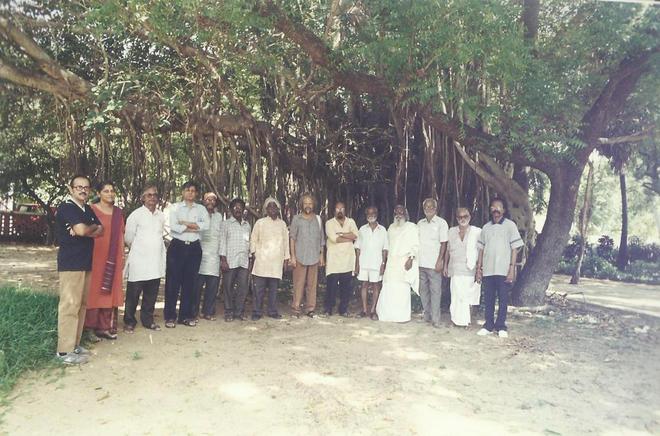A childlike joy sneaks up on sculptor and artist PS Nandhan whenever he speaks of his art. Eyes lit up, he traces his now-frail fingers along lines that once were starting points to an amorphous figure in stone, or an abstract Ganesha in terracotta. These strokes are spread across his paintings and sculptures and are, in his words, what set the path to a realised work. Today, at DakshinaChitra Museum’s well-lit Varija Gallery, from early paintings and daily sketches, to large format sculptures and scrolls, a condensed take on the artist’s life comes alive as a retrospective show that he had always dreamt of.
“When we think of PS Nandhan, we only think of sculptures. It was surprising for me to discover that painting, in fact, was his first love. Not many people know that,” says Gita Hudson, whose curation throws light on Nandhan’s entire body of work through pathways to each decade of his life as an artist. And so, the narrative of the display starts in the 1960s when Nandhan’s paintings had a character different from what we see today in his sculptures. Colours stand out, frames are crowded, and figures are defined: reminiscent of the school of the prolific Madras Art Movement.

Down the years, sculptures became his mainstay, but the strokes that take on the material form arise from his painting technique. “It is difficult to bring movement into sculptures. The strokes usually come from my painting practice,” says Nandhan, who at 80, draws every day. “Drawing to me is like sadhana to a musician,” he says.
Clay was one of his favourite playthings as a six-year-old in Tamil Nadu’s Madhuranthakam: an early initiation into the world of sculptures. He started with the form of Vinayagar (Ganesha). Today, he has finished 80 sculptures of Ganesha.
“Every medium is like water to me,” he says, “I don’t start a work with a form in mind. The pen, brush or chisel leads me.” A strong belief in this philosophy has followed him through six decades of continuous work. This consistency is built on an almost-blind devotion to the ‘line’. “If you are not patient, the line will progress slowly. Distractions will be rife. If the concentration is intact, it takes only a few seconds for the line to lead your hand,” says Nandhan. His famous Buddha sculpture is testament to this: nowhere in the country will you see a Buddha with a hollowed-out head: an invitation for the viewer to look inwards. “It started off as a clay sculpture which was later translated into stone,” he adds.
Nandhan’s forms shy away from linear progression: he says with pride that he does not conform to the traditional way of building the form from a face. He likes to build upwards, from the base. He recounts pointing to how unpredictable his process is: “There was a stone that was lying around for almost 10 years which gave me no inspiration. In anger, I hit it hard with a hammer. A part of it chiseled away. The next day I came back to the broken stone, and a form made itself seen. That’s why I say there is God in art.”
It was KCS Paniker who taught him that the scale of an artwork has no bearing on creative prowess. First, as the highly observant principal of the Egmore College of Arts, and then as the founder of Cholamandal Artists Village, where Nandhan would live and work for over six decades. It was the same Paniker who told him, a keen, rather nervous student that by learning other skills, a certain sense of finesse can be brought to the medium of sculpture. Painting and drawing was Nandhan’s answer to upskilling.
Though even through the pandemic, he worked on large sculptures, he has now retired to dabbling with ceramic and clay in a much smaller scale. While health is the driving force for this, he refuses to pause. Even for a day. “
A Retrospective on PS Nandhan is on view at Varija Gallery, DakshinaChitra Museum until May 31.







